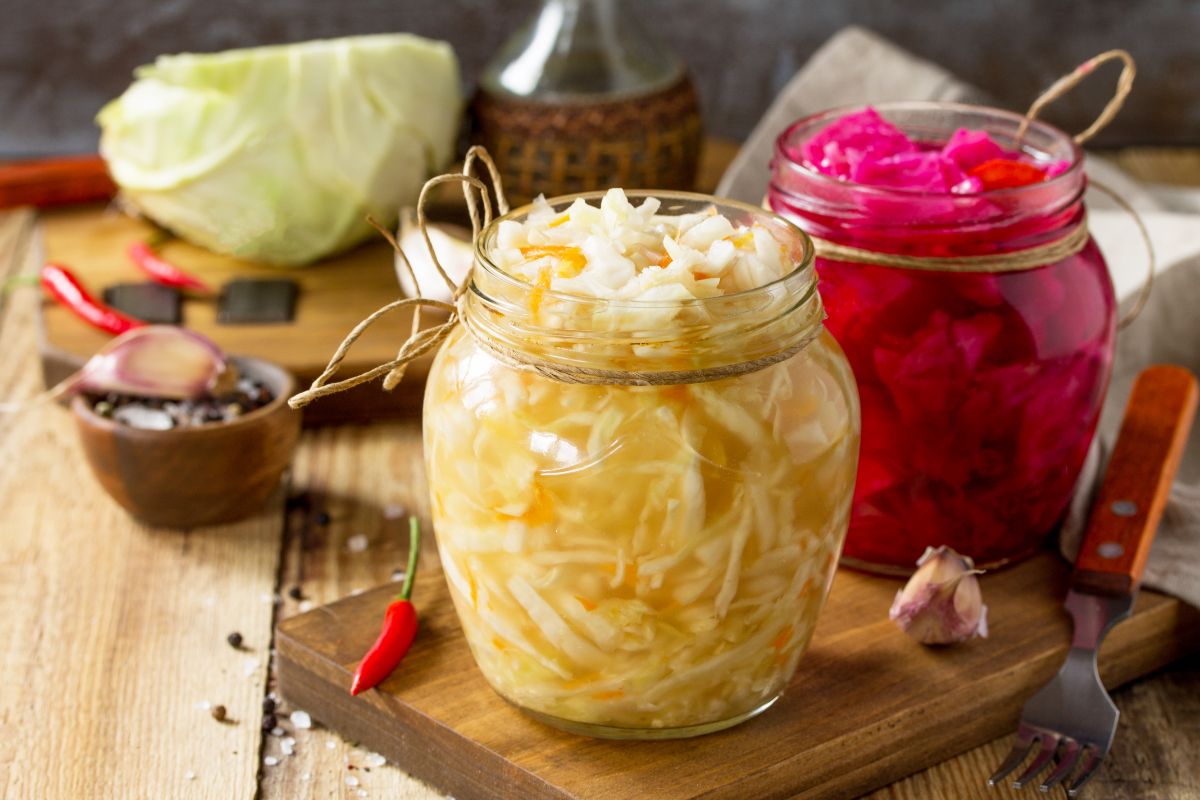Pressure canning cabbage is possible but the cabbage must be pickled or fermented first. Raw cabbage isn’t suitable for canning because of its low acidity and the thickness of the leaves. Many canners prefer to make sauerkraut to safely preserve cabbage.
Is it Possible to Can Cabbage?
Yes – canning cabbage is possible if it is pickled or cooked first. Cabbage is a low-acid food that requires cooking or fermenting to preserve its color, flavor, and texture.
Raw cabbage should not be canned. There is a high risk of botulism, and neither the USDA nor the National Center for Home Food Preservation provides directions for canning raw cabbage. Even the Blue Ball Canning Guide has removed water-bath cabbage canning recipes from its volumes since 1977.
The Best Way of Canning Cabbage
The best method for canning heads of cabbage is pickling and then pressure-canning them. The vinegar in a pickling solution raises the acidity of your veggies, making them safe to store and eat.
Follow these steps to pickle cabbages and prepare them for canning:
- Choose fresh, crisp cabbages. Remove the thick outer leaves and stem.
- Rinse the leaves with cold water, and cut them into quarters, removing the core.
- Shred the cabbage into small pieces.
- Pack the shredded cabbage in clean, sterile glass mason jars.
- Create a brine with your recipe, using white vinegar or red wine vinegar and boiling water. The vinegar should have an acidity of at least 5%.
- Add 1 tsp of canning salt and 1 tsp of sugar per pint jar and allow the brine to boil for 5 minutes.
- Pour the hot brine into your jars, leaving 1-inch headspace.
- Use a spoon to remove excess air bubbles.
- Wipe the rims of the jars with a paper towel before covering the jars with lids.
- Apply screw bands until they are fingertip tight.
Pressure Canning Pickled Cabbage
Once your jars are filled and sealed, follow these steps:
- Prepare your pressure canner by adding 4 inches of water, ensuring the jar rack is inside. Place the canner on the stove over low heat.
- Using a jar lifter, place your jars onto the rack inside the canner.
- Add more water if required by the manufacturer’s instructions.
- Close the lid to the canner and let it vent steam for at least 10 minutes.
- Adjust the PSI to the appropriate level based on the type of pressure canner you use and your elevation.
PSI for pickled cabbage (pints and quarts) in a dial gauge canner:
| Elevation | 0 – 2,000ft | 2,001ft + |
| Pressure | 11lbs | 12lbs |
PSI for pickled cabbage (pints and quarts) in a weighted canner:
| Elevation | 0 – 1,000ft | 1,001ft + |
| Pressure | 10lbs | 15lbs |
- Once the canner reaches the correct pressure, process the jars for 20 minutes.
- Allow the pressure to return to zero before opening your canner.
- Turn the heat off once the processing time is complete.
- Carefully remove the jars without jostling them, and let them cool to room temperature for 12-24 hours.
- Once cool, check the seals and label jars with dates.
- Store the labeled jars in a cool, dry place.

Fermenting and Canning Sauerkraut Recipe
- Total Time: 21 days, 16 hours
Description
Home canning sauerkraut has never been easier! This recipe makes 36 pints so you can enjoy sauerkraut all year long!
Ingredients
- 50 pounds cabbage
- 2 cups of canning/pickling salt (divided)
Instructions
- Remove a few of the outer cabbage leaves to expose the fresh, inner cabbage head.
- Split the cabbage into quarters, removing the inner core.
- Use a food processor, mandoline, or chef’s knife to slice the cabbage into thin pieces.
- In a large bowl, add 5 pounds of shredded cabbage with 3 tablespoons of pickling salt and mix to combine.
- Allow the mixture to sit for 5 minutes, then press on the mixture with your hands or a wooden spoon until you see liquid pooling at the top.
- Continue adding cabbage to the bowl, 5 pounds at a time, adding salt with each addition and pressing firmly to ensure liquid pools at the top.
- If no liquid forms, you will need to create a simple brine of salt and water and add enough to just cover the top of the cabbage.
- Use a cheesecloth to cover the bowl, and place a heavy bowl on top to ensure the cabbage is beneath the surface of the water.
- Allow the bowl to sit in a warm room (70°F – 75°F) for 2 – 3 weeks.
- Check on the bowl periodically, and remove any blue or orange-tinted liquid that forms along the top. This is a type of yeast that can disrupt the fermentation process if the cabbage is not protected by water and should be immediately removed.
- Once you’re ready to can the sauerkraut, prepare 36 pint jars (or 18 quart jars) for canning by washing and sterilizing the jars, lids, and screw bands.
- Heat the sauerkraut in the brining liquid on the stove to between 125°F – 210°F. Ensure the mixture doesn’t boil.
- Transfer and pack the sauerkraut into hot jars, leaving a ½ inch headspace. Use a clean spoon or spatula to eliminate air bubbles.
- Wipe the rims of the jars clean with a paper towel. Cover with lids and tighten the screw bands to fingertip tight.
- Place a rack in a large stainless steel stock pot or water bath canner and fill halfway with water – bring to a boil.
- Carefully add the jars of sauerkraut using a jar lifter and add boiling water to one inch above the tops of the jars.
- Cover with a lid and process pint jars for 15 minutes and quart jars for 20 minutes.
- Uncover the canner and carefully remove the hot jars. Place them on a countertop for 12-24 hours to cool undisturbed.
- Check that the jars are sealed and remove the screw bands.
- Label the jars of sauerkraut and move them to a cool, dry place to store them. Enjoy!
- Prep Time: 1 hour
- Additional Time: 21 days, 13 hours
- Cook Time: 2 hours
Nutrition
- Serving Size: 1 cup
- Calories: 36
- Sugar: 3.4g
- Sodium: 1249mg
- Fat: 0.3g
- Carbohydrates: 8.1g
- Fiber: 5.5g
- Protein: 1.7g
What is the Shelf Life of Canned Cabbage?
It is recommended to consume low-acid canned vegetables such as canned cabbage within 1-3 years for the best quality. Once canned cabbage has been opened, it should be placed in a refrigerator and used within 2 – 3 days. Be sure to label and date your canned cabbage to know when to consume it.
How to Store Canned Cabbage
Canned cabbage should be stored in a cool, dry place to extend its shelf life. Store sealed jars away from light, heat, and humidity.

